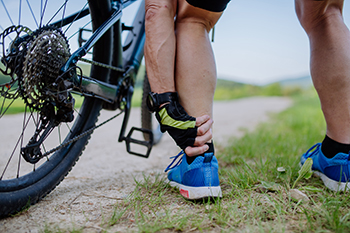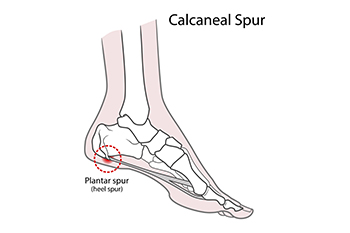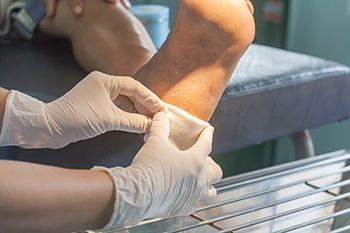Connect With Us
Blog
Items filtered by date: July 2024
Common Foot Injuries Among Skaters

Skaters often encounter various foot injuries due to the rigorous demands placed on their feet. Wearing tight-fitting boots can lead to issues like lace bite, where the pressure from laces causes pain and inflammation across the top of the foot. Blisters are another common problem, caused by friction and repetitive motion in ill-fitting skates. Achilles tendon injuries are prevalent due to the intense strain during jumps and spins, resulting in pain and stiffness in the back of the ankle. Additionally, skaters may develop malleolar bursitis, inflammation of the fluid-filled sacs around the ankle bones, from constant rubbing against skate boots. Understanding these injuries is essential for skaters to adjust their equipment and practice proper stretching and strengthening exercises. If you enjoy skating and have incurred a foot or ankle injury, it is suggested that you contact a podiatrist who can treat any foot condition, and guide you on additional injury prevention techniques.
Foot Pain
Foot pain can be extremely painful and debilitating. If you have a foot pain, consult with Emmanuel Bustos, DPM from New York. Our doctor will assess your condition and provide you with quality foot and ankle treatment.
Causes
Foot pain is a very broad condition that could be caused by one or more ailments. The most common include:
- Bunions
- Hammertoes
- Plantar Fasciitis
- Bone Spurs
- Corns
- Tarsal Tunnel Syndrome
- Ingrown Toenails
- Arthritis (such as Gout, Rheumatoid, and Osteoarthritis)
- Flat Feet
- Injury (from stress fractures, broken toe, foot, ankle, Achilles tendon ruptures, and sprains)
- And more
Diagnosis
To figure out the cause of foot pain, podiatrists utilize several different methods. This can range from simple visual inspections and sensation tests to X-rays and MRI scans. Prior medical history, family medical history, and any recent physical traumatic events will all be taken into consideration for a proper diagnosis.
Treatment
Treatment depends upon the cause of the foot pain. Whether it is resting, staying off the foot, or having surgery; podiatrists have a number of treatment options available for foot pain.
If you have any questions, please feel free to contact our office located in New York, NY . We offer the newest diagnostic and treatment technologies for all your foot care needs.
Ankle Pain While Cycling

Ankle pain while cycling can stem from various factors related to bike fit, technique, or underlying conditions. Improper bike setup, such as incorrect saddle height or pedal position, can strain the ankles during pedaling. Poor cycling techniques, like excessive ankle flexion or inadequate warm-up, may also contribute to discomfort. Common parts of the ankle affected by cycling include the Achilles tendon, which can become inflamed due to repetitive motion, and the ankle joint itself, which is susceptible to overuse injuries like sprains or strains. Additionally, conditions such as tendonitis or arthritis can exacerbate pain. Ensuring proper bike fit, warming up before rides, and maintaining good ankle flexibility and strength through targeted exercises can help prevent ankle pain. If you enjoy cycling and have endured an ankle injury, it is suggested that you consult a podiatrist who can offer treatment solutions, in addition to providing ankle injury prevention tips.
Ankle pain can have many different causes and the pain may potentially be serious. If you have ankle pain, consult with Emmanuel Bustos, DPM from New York. Our doctor will assess your condition and provide you with quality foot and ankle treatment.
Ankle pain is any condition that causes pain in the ankle. Due to the fact that the ankle consists of tendons, muscles, bones, and ligaments, ankle pain can come from a number of different conditions.
Causes
The most common causes of ankle pain include:
- Types of arthritis (rheumatoid, osteoarthritis, and gout)
- Ankle sprains
- Broken ankles
- Achilles tendinitis
- Achilles tendon rupture
- Stress fractures
- Tarsal tunnel syndrome
- Plantar fasciitis
Symptoms
Symptoms of ankle injury vary based upon the condition. Pain may include general pain and discomfort, swelling, aching, redness, bruising, burning or stabbing sensations, and/or loss of sensation.
Diagnosis
Due to the wide variety of potential causes of ankle pain, podiatrists will utilize a number of different methods to properly diagnose ankle pain. This can include asking for personal and family medical histories and of any recent injuries. Further diagnosis may include sensation tests, a physical examination, and potentially x-rays or other imaging tests.
Treatment
Just as the range of causes varies widely, so do treatments. Some more common treatments are rest, ice packs, keeping pressure off the foot, orthotics and braces, medication for inflammation and pain, and surgery.
If you have any questions, please feel free to contact our office located in New York, NY . We offer the newest diagnostic and treatment technologies for all your foot care needs.
Minimally Invasive Surgery for Heel Spurs
 Heel spurs are bony growths that develop on the underside of the heel bone, often causing heel pain. They form when calcium deposits build up over time, usually due to strain on foot muscles and ligaments, stretching of the plantar fascia, or repeated tearing of the membrane that covers the heel bone. People most at risk include those with flat feet or high arches, athletes who engage in a lot of running and jumping, and individuals who are overweight or wear poorly fitted shoes. Symptoms of heel spurs include sharp pain in the heel, especially while standing up in the morning or after sitting for a long time, and a feeling of a small, hard lump under the heel. Treatment generally involves rest, wearing orthotic inserts, gentle exercises, and taking anti-inflammatory medications. However, for persistent pain, a minimally invasive procedure called a percutaneous plantar fasciotomy, which involves releasing tension in the fascia can be an alternative to surgically removing the spur. If you think you have a heel spur, it is suggested that you schedule an appointment with a podiatrist for a proper diagnosis and treatment plan that is right for you.
Heel spurs are bony growths that develop on the underside of the heel bone, often causing heel pain. They form when calcium deposits build up over time, usually due to strain on foot muscles and ligaments, stretching of the plantar fascia, or repeated tearing of the membrane that covers the heel bone. People most at risk include those with flat feet or high arches, athletes who engage in a lot of running and jumping, and individuals who are overweight or wear poorly fitted shoes. Symptoms of heel spurs include sharp pain in the heel, especially while standing up in the morning or after sitting for a long time, and a feeling of a small, hard lump under the heel. Treatment generally involves rest, wearing orthotic inserts, gentle exercises, and taking anti-inflammatory medications. However, for persistent pain, a minimally invasive procedure called a percutaneous plantar fasciotomy, which involves releasing tension in the fascia can be an alternative to surgically removing the spur. If you think you have a heel spur, it is suggested that you schedule an appointment with a podiatrist for a proper diagnosis and treatment plan that is right for you.
Foot surgery is sometimes necessary to treat a foot ailment. To learn more, contact Emmanuel Bustos, DPM of New York. Our doctor will assist you with all of your foot and ankle needs.
When Is Surgery Necessary?
Foot and ankle surgery is generally reserved for cases in which less invasive, conservative procedures have failed to alleviate the problem. Some of the cases in which surgery may be necessary include:
- Removing foot deformities like bunions and bone spurs
- Severe arthritis that has caused bone issues
- Cosmetic reconstruction
What Types of Surgery Are There?
The type of surgery you receive will depend on the nature of the problem you have. Some of the possible surgeries include:
- Bunionectomy for painful bunions
- Surgical fusion for realignment of bones
- Neuropathy decompression surgery to treat nerve damage
Benefits of Surgery
Although surgery is usually a last resort, it can provide more complete pain relief compared to non-surgical methods and may allow you to finally resume full activity.
Surgical techniques have also become increasingly sophisticated. Techniques like endoscopic surgery allow for smaller incisions and faster recovery times.
If you have any questions please feel free to contact our office located in New York, NY . We offer the newest diagnostic and treatment technologies for all your foot and ankle needs.
Do You Suffer From Painful Feet?
Podiatrists Are Here for Runners
 For runners, incorporating effective stretches into their routine is vital for performance and injury prevention. The downward dog stretch provides a full-body stretch, focusing on the calves and hamstrings, which helps prevent Achilles tendon injuries. Ankle mobility heel lifts help in strengthening and increasing the flexibility of the ankles, vital for running stability. Besides stretching, wearing proper running shoes cannot be overstated as it ensures adequate support and reduces the risk of injury. It is also important for runners to ease into their routines gradually, allowing their bodies to adjust and build endurance safely. If you have endured a foot or ankle injury while running, it is suggested that you contact a podiatrist who can treat various foot issues and guide you on effective running injury prevention techniques.
For runners, incorporating effective stretches into their routine is vital for performance and injury prevention. The downward dog stretch provides a full-body stretch, focusing on the calves and hamstrings, which helps prevent Achilles tendon injuries. Ankle mobility heel lifts help in strengthening and increasing the flexibility of the ankles, vital for running stability. Besides stretching, wearing proper running shoes cannot be overstated as it ensures adequate support and reduces the risk of injury. It is also important for runners to ease into their routines gradually, allowing their bodies to adjust and build endurance safely. If you have endured a foot or ankle injury while running, it is suggested that you contact a podiatrist who can treat various foot issues and guide you on effective running injury prevention techniques.
All runners should take extra precaution when trying to avoid injury. If you have any concerns about your feet, contact Emmanuel Bustos, DPM of New York. Our doctor will treat your foot and ankle needs.
How to Prevent Running Injuries
There are a lot of mistakes a runner can make prior to a workout that can induce injury. A lot of athletes tend to overstretch before running, instead of saving those workouts for a post-run routine. Deep lunges and hand-to-toe hamstring pulls should be performed after a workout instead of during a warmup. Another common mistake is jumping into an intense routine before your body is physically prepared for it. You should try to ease your way into long-distance running instead of forcing yourself to rush into it.
More Tips for Preventing Injury
- Incorporate Strength Training into Workouts - This will help improve the body’s overall athleticism
- Improve and Maintain Your Flexibility – Stretching everyday will help improve overall performance
- “Warm Up” Before Running and “Cool Down” Afterward – A warm up of 5-10 minutes helps get rid of lactic acid in the muscles and prevents delayed muscle soreness
- Cross-Training is Crucial
- Wear Proper Running Shoes
- Have a Formal Gait Analysis – Poor biomechanics can easily cause injury
If you have any questions, please feel free to contact our office located in New York, NY . We offer the newest diagnostic and treatment technologies for all your foot care needs.
Wound Care for Diabetic Foot Ulcers

Diabetic foot ulcers are categorized into three main types, which are neuropathic, ischemic, and neuroischemic. Neuropathic ulcers develop due to nerve damage, leading to a loss of sensation and unnoticed injuries. Ischemic ulcers result from poor blood circulation, reducing the body's ability to heal. Neuroischemic ulcers combine both nerve damage and poor circulation, making them particularly challenging to treat. These ulcers develop because high blood sugar levels impair circulation and nerve function, increasing the risk of infection. Effective wound care involves maintaining strict blood sugar control, keeping the ulcer clean, and using appropriate dressings to promote healing. Regular foot inspections are essential to detect issues early. Specialized footwear or orthotics can relieve pressure on the ulcer. Severe cases may require medical interventions, such as debridement or surgery. If you have diabetes and have developed a foot wound, it is strongly suggested that you are under the care of a podiatrist who can provide you with the care and advice that is needed.
Wound care is an important part in dealing with diabetes. If you have diabetes and a foot wound or would like more information about wound care for diabetics, consult with Emmanuel Bustos, DPM from New York. Our doctor will assess your condition and provide you with quality foot and ankle treatment.
What Is Wound Care?
Wound care is the practice of taking proper care of a wound. This can range from the smallest to the largest of wounds. While everyone can benefit from proper wound care, it is much more important for diabetics. Diabetics often suffer from poor blood circulation which causes wounds to heal much slower than they would in a non-diabetic.
What Is the Importance of Wound Care?
While it may not seem apparent with small ulcers on the foot, for diabetics, any size ulcer can become infected. Diabetics often also suffer from neuropathy, or nerve loss. This means they might not even feel when they have an ulcer on their foot. If the wound becomes severely infected, amputation may be necessary. Therefore, it is of the upmost importance to properly care for any and all foot wounds.
How to Care for Wounds
The best way to care for foot wounds is to prevent them. For diabetics, this means daily inspections of the feet for any signs of abnormalities or ulcers. It is also recommended to see a podiatrist several times a year for a foot inspection. If you do have an ulcer, run the wound under water to clear dirt from the wound; then apply antibiotic ointment to the wound and cover with a bandage. Bandages should be changed daily and keeping pressure off the wound is smart. It is advised to see a podiatrist, who can keep an eye on it.
If you have any questions, please feel free to contact our office located in New York, NY . We offer the newest diagnostic and treatment technologies for all your foot care needs.
